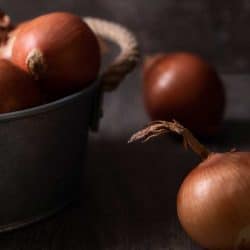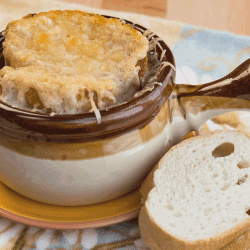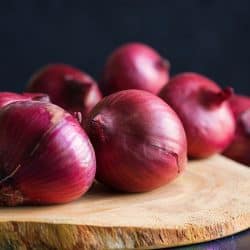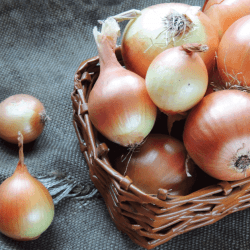The onion is a staple food in nearly every kitchen. No matter how you slice or dice it, onion can be eaten raw or cooked. When added to numerous recipes, the onion provides an abundance of flavor. If you like to prepare onion ahead of time to use in the kitchen, you are probably wondering how to store a cut onion. We’ve researched this to get the answer for you.
The best way to store a cut onion is by placing it into an airtight storage container and keeping it in the refrigerator until you are ready to use it.
If you are now in search of the right container for a cut onion, keep reading. We’ve got that answered too. Check out several airtight containers to keep your onion fresher longer, and prevent co-mingled odors in your refrigerator.

Is It Safe to Store Cut Onions in the Refrigerator?
The refrigerator is the safest storage location for cut onions because cool temperatures inhibit bacterial growth. If you store cut onions in an airtight container, they will last between 7 to 10 days in the refrigerator. Chopped onions exposed to warm air degrade more quickly by discoloring, drying out, and losing flavor. Let’s take a closer look at some of the containers you can use to lock-in freshness for your cut onions.
Airtight, Reusable Container
Eco-friendly, reusable containers are an excellent option for storing cut onions because airtight lids lock freshness inside. Using a plastic, steel, or glass container ensures that onion odors do not co-mingle with other foods in the fridge, and vise versa.
Click here to find this on Amazon.
Silicone Stretch Lids
Coordinate your mixing bowls, serving bowls, and ramekins with silicone stretch lids by choosing from a variety of sizes and vibrant colors. Made from food-grade silicone that withstands temperatures between -50°F to 450°F, flexible lids are ideal for refrigerator or freezer use. Silicone stretch lids reduce co-mingling of odors and flavors to keep cut onions fresher longer.
Click here to find this on Amazon.
Ziploc Bag
The name ‘Ziploc’ is synonymous with freshness. Toss cut onions into a resealable, reusable plastic bag and press the zipper to seal in flavor and keep out unwanted, lingering odors.
Silicone Bag
Food safe, reusable silicone storage bags are an eco-friendly alternative to plastic storage bags. Toss cut onions into the bag and pull the zip-slider closed for an airtight seal.
Click here to find this on Amazon.
Plastic (or Saran) Wrap
Plastic wrap is excellent for larger onion pieces, like quarters or halves. Wrap the plastic snugly around the entire onion piece, then twist or fold excess plastic to keep the wrap as tight as possible.
Click here to find this on Amazon.
Beeswax Wrap
Beeswax wraps are a 100% organic, reusable alternative to plastic wrap. Made from cotton, beeswax, and natural oils, wraps are fashioned in patterns to coordinate with your kitchen. Various sizes accommodate large or small pieces of onion. Simply wrap the cut onion snugly and press tacky ends of the wrap together to create a tight seal.
Click here to find this on Amazon.
How Long Does Cut Onion Last In the Fridge?
If stored in an airtight container, any variety of cut onion (half, quarter, or chopped) will last up to two weeks stored in the refrigerator.
Before using cut onion that has been refrigerated, check to make sure the pieces are not spoiled and discard the onion if you observe:
- Unusual color (milky white or blackened).
- Unusual or potent odor.
- Unusual texture (mushy, slimy, or moldy).
Is It OK to Cut Up Onions Ahead of Time?
You can cut onions ahead of time, particularly if using onions as an accent in your recipe. Cook’s Illustrated recommends cutting onions immediately before use, to get the most flavor if serving onions raw or as the focal point of your dish.
If you do not plan to cook cut onions immediately, the USDA recommends refrigerating within two hours of prepping to keep food out of the danger zone (40°F to 140°F) where harmful bacteria potentially grow.
Does Onion Go Bad If Not Refrigerated?
Keeping onion fresh largely depends on whether the onion is whole, peeled, or cut. Because cut onion degrades when exposed to air and moisture, drying out and losing flavor, it is best kept airtight in the refrigerator. Likewise, peeled onion stays fresher longer if stored airtight and refrigerated.
Store whole onions in a cool, dry, dark location. If whole onions are stored in the refrigerator, they will absorb moisture to become soggy. Keep whole onions out in a well-ventilated area. There is no need to store whole onions in a bag, wrap, or container. Whole onions will stay fresh in their own skin for at least a month or longer.
Can You Freeze a Cut Onion?
The key to freezing cut onion is to store the onion in an airtight container and also try to remove any excess moisture from the container to avoid freezer burn. A chopped onion will freeze more evenly than halves or quarters. Remember to label the container with the date it was frozen, and you can plan to store cut onion in the freezer for up to 8-months.
Do Onions Get Stronger After Cutting?
When you cut an onion, you also cut its cells and cause various chemical reactions to occur. The cells release enzymes called alliinases that react with proteins to create thiosulfinates. That’s a lot of science happening all at once. Simply put, thiosulfinates are the intense flavors and pungent odors that get released when you cut an onion as a result of ruptured cells.
If you cut an onion horizontally (along the equator), you are slicing it against the grain. When cut horizontally, the onion has stronger taste and odor because many cells are ruptured.
If you cut an onion lengthwise (end-to-end), you are slicing it with the grain. Cut lengthwise, the taste and odor are slightly less pungent because fewer cells are ruptured.
Why Do Cut Onions Make Me Cry?
As soon as you cut an onion, it goes into defense mode by releasing a volatile chemical called propanthial s-oxide. In nature, this bitter-tasting chemical deters animals from eating the entire plant. In your kitchen, this chemical quickly evaporates once released. Propanthial s-oxide finds its way into your eyes and dissolves in the water in your eyes to irritate.
You can reduce the number of chemicals released by either blanching, refrigerating, or freezing the onion just before cutting it. If you need a quick solution once you’ve started cutting, rinse the freshly chopped onion in cold water and then proceed. Of course, you could also try wearing a pair of goggles while you cut onions. But, you will only be making a new fashion statement because pesky propanthial s-oxide will slowly find its way behind the goggles and into your eyes.
Hopefully, you find these onion storing techniques useful in your kitchen. Check out our blogs for even more, excellent food storage ideas:
Is It Better to Store Food in Plastic, Glass, or Stainless Steel?







![Loose onions scattered from wicker basket and one onion cut in halves on suckcloth, What's The Best Way To Store Onions? [Best Storage Options Discussed]](https://kitchenseer.com/wp-content/uploads/2020/08/Loose-onions-scattered-from-wicker-basket-250x250.jpg)



![A delicious baked onion soup with French bread on the table, 9 Lipton Onion Soup Mix Substitutes [Including Homemade]](https://kitchenseer.com/wp-content/uploads/2021/12/A-delicious-baked-onion-soup-with-french-bread-on-the-table-250x250.jpg)
